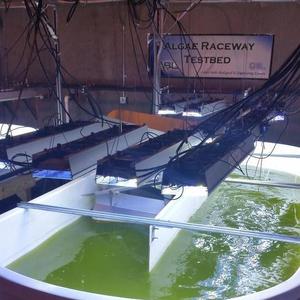Algae raceway paves path from lab to real-world applications

Photo: Dino Vournas, Sandia National Laboratories
February 9, 2016
BY DOE/Sandia National Laboratories
In a twist of geometry, an oval can make a line. The new algae raceway testing facility at Sandia National Laboratories may be oval in shape, but it paves a direct path between laboratory research and solving the demand for clean energy.
As the nation and California adopt policies to promote clean transportation fuels, that path could help bring the promise of algal biofuels closer to reality. As one of the fastest growing organisms on the planet, algae are an ideal source of biomass, but researchers have not yet found a cost-competitive way to use algae for fuels.
“This facility helps bridge the gap from the lab to the real world by giving us an environmentally controlled raceway that we can monitor to test and fine tune discoveries,” said Ben Wu, Sandia’s biomass science and conversion technology manager.
“The success of moving technologies from a research lab to large outdoor facilities is tenuous. The scale-up from flask to a 150,000-liter outdoor raceway pond is just too big.”
Advertisement
The new Sandia algae testing facility consists of three 1,000-liter raceway ponds with advanced monitoring provides new advantages to researchers:
- Easy scale-up to larger, outdoor raceways
- Customizable lighting and temperature controls, operational by year end, to simulate the conditions of locations across the country
- Fully contained for testing genetic strains and crop protection strategies
- Advanced hyperspectral monitoring 24 hours a day
Advertisement
Several ongoing projects will use the algae raceway right away. Researchers Todd Lane and Anne Ruffing will test genetically modified algae strains as part of a project funded by Sandia’s laboratory directed research and development program. The algae raceway will allow the researchers to more quickly identify strains that promise improved performance.
Lane is also part of a project partnership with Lawrence Livermore National Laboratory funded by the U.S. DOE’s Bioenergy Technologies Office that is investigating a probiotic approach to algae crop protection.
Another BETO project seeks to convert algae proteins into useful chemical compounds such as butanol. Wu expects the facility will expand opportunities for Sandia researchers to develop algae as a robust source of biofuels and increase collaborations and partnerships with the private sector, particularly in California where efforts to transform transportation energy are prevalent.
“The bioeconomy is gaining momentum,” he said. “Biofuels from algae may be further off, but algae has sugar and proteins that can make fuel or higher valued products, such as butanol or nylon—products that currently come from fossil fuels.”
Sandia National Laboratories is a multiprogram laboratory operated by Sandia Corp., a wholly owned subsidiary of Lockheed Martin Corp., for the DOE’s National Nuclear Security Administration. With main facilities in Albuquerque, New Mexico, and Livermore, California, Sandia has major R&D responsibilities in national security, energy and environmental technologies and economic competitiveness.
Related Stories
Scientists at ORNL have developed a first-ever method of detecting ribonucleic acid, or RNA, inside plant cells using a technique that results in a visible fluorescent signal. The technology could help develop hardier bioenergy and food crops.
The 2025 International Fuel Ethanol Workshop & Expo, held in Omaha, Nebraska, concluded with record-breaking participation and industry engagement, reinforcing its role as the largest and most influential gathering in the global ethanol sector.
TotalEnergies and Quatra, the European market leader in the collection and recycling of used cooking oil, have signed a 15-year agreement beginning in 2026, for the supply of 60,000 tons a year of European used cooking oil.
The USDA maintained its forecast for 2025-’26 soybean oil use in biofuel production in its latest World Agricultural Supply and Demand Estimates report, released June 12. The estimate for 2024-’25 soybean use in biofuel production was revised down.
SkyNRG on June 5 released its fifth Sustainable Aviation Fuel Market Outlook. The report, developed in collaboration with ICF, highlights the need to scale up technologies and feedstocks that are an alternative to HEFA fuels.
Upcoming Events










